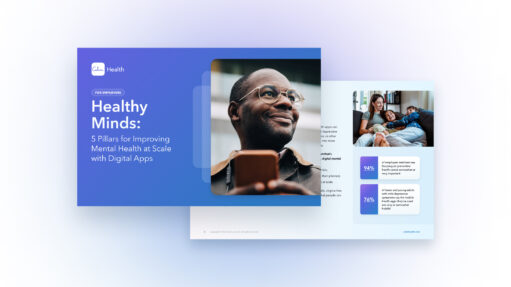Clinically reviewed by Chris Mosunic, PhD, RD, MBA, Chief Clinical Officer, Calm
Alarming rates of burnout among nurses and physicians continue to threaten their well-being, quality of care, and, ultimately, patient outcomes. Almost two-thirds of nurses (65%) and nearly half of physicians (47%) report experiencing burnout, a state of emotional and physical exhaustion.
Predictably, nurse and doctor burnout stems primarily from chronic staffing shortages that create a set of distressing and unsustainable working conditions, including heavy patient loads, excessive working hours, and the burden of too many administrative tasks. And with burnout comes costly attrition, more severe staffing shortages, greater strain on resources, and more chronic stress and burnout. It’s a vicious cycle that healthcare leaders must interrupt to protect their staff, patients, and organizations.
Yet the very factors driving burnout also risk normalizing it. Patient overload, the administrative burden, and long hours are so entrenched in health care that they may increasingly be seen as just part of the job. In this environment, nurse and physician burnout may be harder to recognize and address.
So, how can healthcare leaders recognize signs of burnout and mitigate them before the crisis deepens?
Recognizing the classic signs of burnout in healthcare workers
The first step in addressing healthcare burnout is understanding what it looks like. The Maslach Burnout Inventory, the leading measure of burnout, describes three core dimensions of burnout in medical personnel:
- Emotional exhaustion: a chronic state of physical and emotional depletion that leaves a person feeling emotionally overextended, drained, overwhelmed, or unable to cope. A healthcare professional might say something like “I feel like I’m at the end of my rope” when they feel emotionally exhausted.
- Depersonalization: a sense of emotional detachment from or cynicism about patients and colleagues that’s often used as a coping mechanism to manage stress. As a defense mechanism, healthcare workers may emotionally distance themselves from patients, at times treating them more as conditions or cases than individuals.
- Reduced personal accomplishment: a declining sense of competence and fulfillment in one’s work that leads to feelings of ineffectiveness or failure. Even when patient outcomes are good, a healthcare professional may feel they’re not contributing in a meaningful way.
Healthcare workers experiencing burnout could begin calling in sick or request unscheduled time off due to exhaustion. Or they might appear disengaged or unusually quiet during their shifts when they’re normally high performers. Other signs of burnout are pulling back from team conversations or collaborative moments in uncharacteristic ways or paying less attention to detail, putting quality of care and patient safety at risk.
Why burnout is getting harder to spot
Despite the serious risks posed by healthcare staff burnout, its signs are often overlooked in clinical environments in which intensity is the norm. In under-resourced healthcare settings, a constant state of stress is often expected. Healthcare workers might adopt a “push through it” mindset, internalizing exhaustion as a normal part of the job. Healthcare leaders may construe a worker’s exhaustion and other signs of burnout as normal responses to “just another tough day” amid resource constraints. Of course, resource constraints also affect managers; they could be stretched too thin to detect shifts in the behavior of their staff.
Fear, shame, and stigma also play significant roles in keeping healthcare burnout in the shadows. Healthcare workers might hide their struggles because they fear being judged as lazy or jeopardizing their medical license and future job prospects. Instead of seeking help, they might intentionally mask signs of burnout using humor or by overachieving.
In fact, high-functioning burnout occurs when a worker is able to maintain high levels of productivity even while feeling emotionally depleted. They may set exceptionally high standards for themselves, disregarding the cost to their well-being while eluding detection by others.
The risks of missing or misreading burnout in healthcare
Failing to recognize or address burnout can wreak havoc on the lives of healthcare workers and prove costly for healthcare organizations.
In fact, habitual burnout is associated with anxiety, depression, and substance use disorder. Left unaddressed, these mental health conditions can lead to a wide range of physical health challenges. People with depression are at higher risk for diabetes, stroke, and cardiovascular disease, for example. Without adequate mental health support, healthcare workers may need to go on extended leave or file for disability due to stress-related mental or physical illness.
Unsurprisingly, pervasive health worker burnout jeopardizes the quality of care and patient safety, as exhausted staff are more likely to make errors or struggle with decision-making. Indeed, nurse burnout has been associated with a climate of lower patient safety, more infections originating in the hospital, more medication errors and adverse events, lower patient safety ratings, and lower quality of care—issues that can ultimately impact the financial health of an organization.
And widespread burnout can also have an immediate negative effect on the bottom line. Burnout costs the healthcare industry an estimated $4.6 billion annually, with staff turnover and reduced work hours among primary care physicians representing the greatest cost burden.
How healthcare leaders can surface burnout earlier
Until the severe staffing shortages can be adequately addressed, healthcare leaders will need to take steps to bring burnout out of the shadows and help workers access appropriate and timely support. These steps span culture-building practices, operational practices, and practical digital tools for supporting mental health and well-being.
Prioritize well-being from the top
Leaders play a critical role in normalizing both the mental health conversation and the use of tools, programs, and policies that promote mental health and well-being. When leaders and peers share their own challenges with stress and burnout, along with their solutions, employees are more likely to feel safe using the benefits available to them.
As a first step, encourage leaders across your organization to model vulnerability by being open about their own stress and burnout experiences and how they got through them, highlighting available mental health resources. Another option is to empower supervisors to integrate mental health check-ins into their one-on-one meetings or team meetings with staff members, again focusing on providing a safe space and encouraging them to use available resources.
Outside of one-on-one meetings, consider establishing formal and informal peer support channels so that employees know they’re not alone in their experiences. You might also consider running internal communications campaigns focused on normalizing conversations about stress, burnout, and mental and emotional well-being.
Measure employee well-being regularly
Consider implementing quarterly pulse surveys (if you don’t already use them) that employees can fill out anonymously to express concerns without fear of judgment or reprisal. But first make sure you have a clear idea of what your goals are and how your organization might respond to what you learn. Maintain consistency in your questions to create a baseline and better understand trends in how employees are feeling and engaging with mental health resources.
In addition to regular surveys or digital self-assessments, consider training managers and supervisors to recognize less-obvious signs of burnout, such as social withdrawal, mood changes, or sudden drops in engagement and productivity.
Offer tools that healthcare workers can access easily and confidentially
A perceived lack of confidentiality and wait times are a couple of reasons employees are reluctant to use an employee assistance program (EAP) offered by their organization. Consider augmenting your EAP with digital mental health tools, like Calm Health, that healthcare workers can access anywhere, anytime—even during micro breaks between shifts.
At the same time, make sure that you educate employees about stress, burnout, and the full suite of mental health and well-being resources available to them. Put a comprehensive communications plan in place that helps break down mental health stigma and helps employees keep available tools top of mind. You can take advantage of Mental Health Awareness Month, Black History Month, and many other cultural and awareness moments during the year to emphasize the importance of proactive self-care.
Calm Health helps identify mental health challenges and guides healthcare workers to appropriate support
Calm Health is a digital mental health solution that healthcare professionals can access confidentially around the clock from any location. In just a minute or two, Calm Health’s mental health screening enables workers to better understand how they’re feeling and what their symptoms of anxiety and depression may indicate.
In addition to the worker’s screening results, the program uses self-reported conditions, goals, and topics of interest to guide users to relevant evidence-based programs (e.g., Stress Management for Busy Nurses or Physician Burnout: Protecting Your Well-being), mindfulness tools and exercises, mental health benefits, and other resources.
Calm Health users can retake the mental health screening and update their goals, conditions, and topics of interest at any time, and when they do, they will receive an updated plan of recommendations. It’s a low-lift, high-impact way for leaders to help break through stigma and other mental health barriers and embed self-care into their workplace culture.
Learn how Calm Health supports the mental health and well-being of healthcare workers
Get the e-book
Take steps to mitigate the impact of burnout
Healthcare burnout is a critical, systemic issue that won’t be solved overnight. But in the immediate term, leaders can take important steps to help build awareness about stress and burnout and to destigmatize seeking help. Above all, you can offer tools and resources that can help healthcare professionals gain a better understanding of their mental well-being and give them practical ways to support it.


